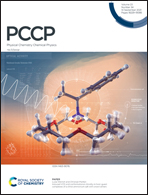Effects of surface contamination on the interfacial properties of CO2/water/calcite systems
Abstract
Understanding the wetting properties of reservoir rocks can be of great benefit for advanced applications such as the effective trapping and geological storage of CO2. Despite their importance, not all mechanisms responsible for wetting mineral surfaces in subsurface environments are well understood. Factors such as temperature, pressure and salinity are often studied, achieving results with little unanimity; other possible factors are left somewhat unexplored. One such factor is the effect of contamination. In the present study, the effects of adding a non-aqueous organic contaminant, ethanol, on the CO2–water interfacial tension (IFT) and the CO2/water/calcite contact angle were investigated using molecular dynamics simulations. Within the conditions studied, relatively small amounts of ethanol cause a significant decrease in the CO2–water IFTs, as well as a pronounced increase in the water-calcite-CO2 three phase contact angle. The latter result is due to the decrease of the IFT between CO2 and water and the strong adsorption of ethanol on the solid substrate. These findings could be helpful for explaining how impurities can affect experimental data and could lead to effective carbon sequestration strategies.



 Please wait while we load your content...
Please wait while we load your content...